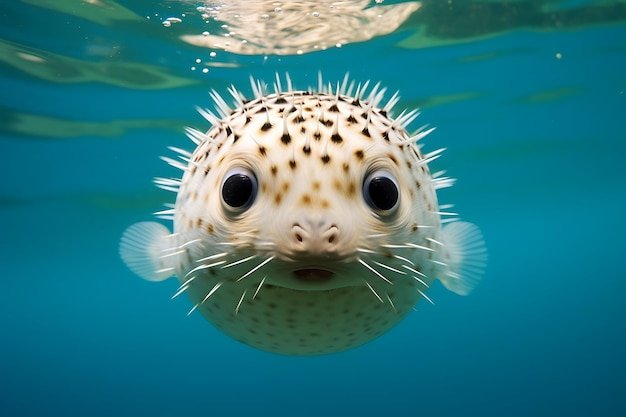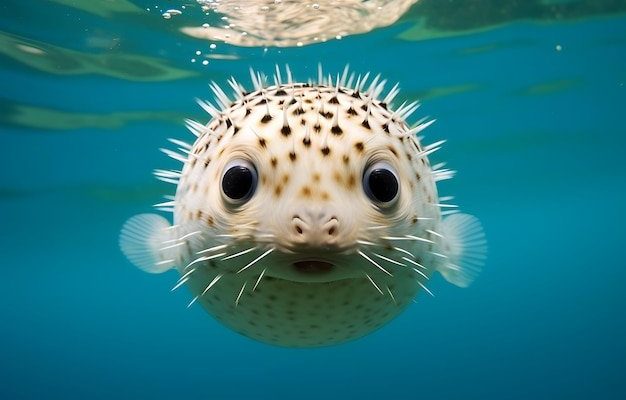
Picture this: you’re in a beautiful coral reef, snorkeling, when you spot a pufferfish resting among the colorful corals. It seems harmless enough, right? But here’s the thing—pufferfish carry some of the deadliest toxins known to man, specifically a substance called tetrodotoxin. It’s like seeing a cute puppy that, unbeknownst to you, has a tendency to bite. So, while the pufferfish might look cuddly and fun, we need to tread carefully. Let’s dive into the world of pufferfish interaction and explore what makes them both enchanting and dangerous.
What Makes Pufferfish Unique?
Pufferfish are part of the Tetraodontidae family, which contains around 120 species. One of the most notable features of pufferfish is their ability to inflate. They can take in water or air to swell up to several times their normal size, which helps them deter predators. It’s their own version of wearing body armor! But beyond this fascinating trick, they have a quirky appearance, with large eyes and a small mouth that makes them look almost cartoonish.
Another interesting aspect is their skin. Pufferfish have tough, spiky skin that adds to their defense. However, that’s not all—many species also contain tetrodotoxin in their organs, skin, and even muscle tissue. This toxin is 1,200 times more lethal than cyanide! It’s like having a built-in poison dart. So, while they might seem like playful sea creatures, they have serious protective measures.
Here’s the thing: while pufferfish can be safe to handle in certain conditions, it’s crucial to know your stuff before even thinking about interacting with them. Understanding their behavior, habitat, and toxicity can help you appreciate them from a safe distance.
Understanding Tetrodotoxin
Tetrodotoxin is where things get serious. This powerful neurotoxin affects the nervous system and can cause paralysis, respiratory failure, and even death. You might be wondering why something so deadly exists in such a cute fish. The answer lies in evolution—fish that can defend themselves from predators tend to survive longer and reproduce more. It’s nature’s way of keeping things in balance.
Interestingly, not all pufferfish contain the same amount of tetrodotoxin. Some have a high concentration, while others may be less toxic or even harmless under certain conditions. However, it’s crucial to never assume safety. Even a small amount of toxin can be lethal.
If you’re thinking of interacting with pufferfish, remember that consuming them is a whole other ball game! In some cultures, pufferfish is considered a delicacy, known as fugu in Japan. Chefs must undergo extensive training to prepare it safely because one slip-up can be fatal. So, unless you’re trained, it’s best to admire these creatures from afar.
Safe Ways to Observe Pufferfish
So, how do you appreciate these fascinating creatures without putting yourself at risk? Here are a few ways to enjoy pufferfish safely:
- Snorkeling or Diving: Observing pufferfish in their natural habitat while snorkeling or diving is one of the best ways to enjoy their beauty. Just keep a safe distance!
- Aquariums: Many aquariums have pufferfish on display. This allows you to observe them closely while ensuring you’re safe from their toxins.
- Photography: If you’re a photographer, capturing pufferfish through a lens allows you to appreciate their beauty without any direct interaction.
When observing them, remember to move slowly and quietly. Sudden movements can startle pufferfish, causing them to inflate, which is an interesting sight but isn’t ideal for their well-being.
What to Avoid When Interacting with Pufferfish
Avoiding certain situations can make all the difference when it comes to safety. Here’s what you shouldn’t do:
- Handling Them: Resist the urge to touch or grab a pufferfish. Even if it seems friendly, it could react defensively.
- Feeding Them: Feeding pufferfish can disrupt their natural foraging behavior. It’s best to leave them to find their own food.
- Ignoring Their Habitat: Like all wild creatures, pufferfish thrive in their natural environments. Disturbing their habitat can stress them out and harm the ecosystem.
Letting pufferfish exist without interference respects their role in the sea. Remember that they belong to their underwater world, and we’re just visitors.
Learning Through Education
If you’re fascinated by pufferfish, education is key. There are numerous resources available to learn more about them. Books, documentaries, and even online courses can enhance your understanding. You could also join local marine conservation groups or visit marine centers where you can get firsthand information from experts.
Engaging with educational materials helps you appreciate not just pufferfish but marine life as a whole. This knowledge strengthens your respect for the ocean and those who inhabit it. Plus, understanding their behaviors and habitats can make any future interactions more rewarding.
The Bigger Picture: Conservation and Protection
Lastly, let’s not forget about conservation. Many pufferfish species face threats from pollution, habitat destruction, and overfishing. By learning about their lives and the ecosystems they inhabit, we can better contribute to their preservation.
Participating in clean-up efforts, supporting sustainable seafood initiatives, or simply spreading awareness can make a difference. A healthy ocean environment benefits all of us—humans and marine life alike.
Final Thoughts on Pufferfish Interaction
In summary, humans can appreciate pufferfish safely, but it requires a healthy dose of respect and knowledge. Understanding their unique traits, particularly tetrodotoxin, is crucial. While they’re captivating to observe, it’s essential to do so responsibly.
Admiring pufferfish from a distance lets us enjoy their beauty while ensuring both our safety and theirs. So next time you spot a pufferfish, remember to soak in the moment—safely!

